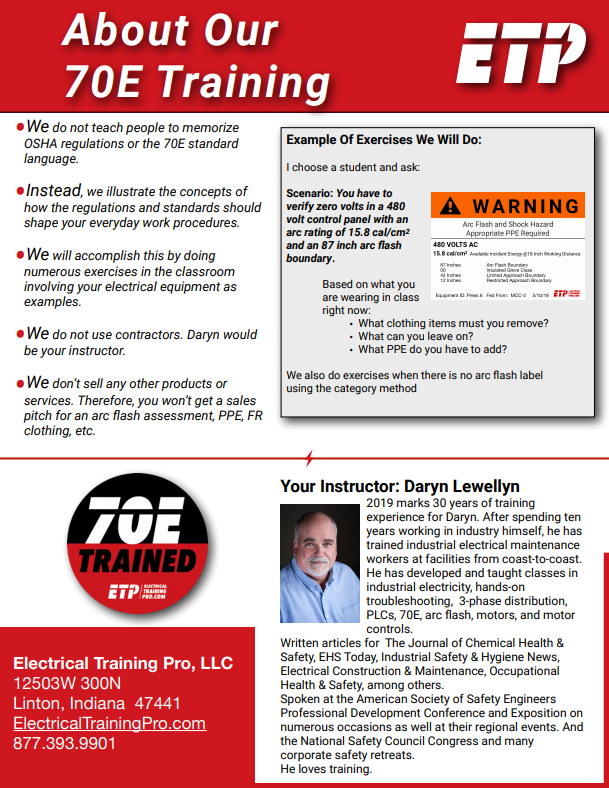What You Get Out Of This Course
This arc flash training course is for anyone working on energized electrical equipment and includes NFPA 70E and OSHA requirements for shock and arc hazards. Attendees will learn the latest in electrical safety standards and regulations. This training goes toward satisfying your OSHA & 70E training requirement and will produce workers more aware of the hazards and how to reduce the risk. This electrical safety training reflects the evolution of NFPA 70E in the direction of risk assessment and hazard elimination. A discussion on the hierarchy of risk controls will be immediately applicable. Students will learn shock and arc flash hazard PPE selection methods. Real-world scenarios and actual OSHA citations will be discussed to find what the group thinks could have avoided the injury, fatality, or citation. We can incorporate into the class your facility’s electrical safety program, arc flash incident-energy-analysis report, and equipment labeling. NFPA 70E & arc flash training is a must. Your people will walk out of this class better prepared for work involving electrical hazards.
Benefits
- Updated For 2024 NFPA 70E
- The Latest Methods For Arc Flash Risk Assessment And PPE Selection.
- Can Be Easily Customized To Fit Your Needs
- 28 Years Experience Teaching In The Maintenance Field
- Instructor Has In-The-Trenches Maintenance Experience
- You Deserve The Best Training Experience Possible, And We Will Do Everything We Can To Provide It.
New For 2024
- Increased Emphasis On Risk Assessment And Away From PPE
- Job Safety Planning Requirement
- Arc Hazard Identification Table Modified To Determine Likelihood Of An Arc Flash, Not If You Should Wear PPE
- Arc Hazard Identification Table Can Be Used For Either Method Of Arc Flash Risk Assessment
- Standards For Arc Flash PPE Moved To Informational Note
- Article 350 Expanded For R&D Laboratories – Electrical safety Authority(ESA)
Who Should Attend
- Electricians
- Multi-Craft Maintenance Personnel
- Engineers
- Supervisors
- Safety Professionals
- Managers
- Electrical Testing Personnel
- Supervisors
NFPA 70E Training Requirement
We can help you with the NFPA 70E training requirement, which calls for qualified workers to be trained at least every three years. It also includes events that trigger retraining, such as evidence the employee is not complying with your electrical safety policy or 70E or a new technology comes into the workplace.
Qualified Worker
A qualified electrical worker, among other things, understands the equipment installation and operation, can identify which parts are live, and can use an appropriate voltmeter to test the circuit and create an electrically safe work condition. That worker must also have received electrical safety training to be able to recognize and reduce the risk of electrical hazards.
They must demonstrate to the employer, through regular supervision and required annual audits that they have the skills and knowledge to be considered qualified.
The employer alone can designate someone as qualified. A training company can only provide the training required.
Deliverables:
- An expert 70E instructor delivering the training
- A course book to keep
- A self-graded test at the completion of the course
- An extra copy of the course book for your files
- A certificate of completion for each attendee
- Sign-In Sheet for documentation
- Test-Before-Touch decals
Arc Flash Training
“Does OSHA require arc flash PPE” is still a question some people ask. OSHA requires an employer to assess all of the risks facing employees and calls explicitly for safety-related work practices for electrical hazards that can occur from direct or indirect contact involving shock or other injuries. OSHA’s track record for writing citations for employers not providing arc flash protection is further evidence.
We will discuss both arc flash PPE selection methods, the category method, and the incident energy analysis method. It will become apparent that both have their pros and cons, and both likely require the involvement of electrical engineers performing power system studies. Reading the equipment labels, assessing the tasks and equipment to enable you to choose the appropriate PPE is very important when working near live energized circuits.
PPE is the last line of defense in an arc flash so our focus will be on eliminating hazards, performing risk assessments, and the hierarchy of risk controls. A de-energized circuit doesn’t have an electrical hazard.
Remember, when you go through the process of lockout/tagout to de-energize the circuit, you are exposed to electrical hazards and must be wearing PPE. Verifying for zero volts is the most crucial step in LOTO. Test before you touch. No circuit is de-energized until you use an appropriate voltmeter you just tested, verify zero volts and then retest your meter.


You must be logged in to post a comment.